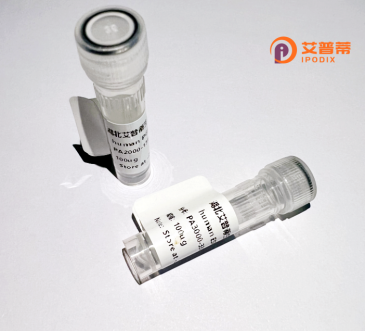
| 纯度 | >90%SDS-PAGE. |
| 种属 | Human |
| 靶点 | AMZ2 |
| Uniprot No | Q86W34 |
| 内毒素 | < 0.01EU/μg |
| 表达宿主 | E.coli |
| 表达区间 | 1-360aa |
| 氨基酸序列 | MQIIRHSEQTLKTALISKNPVLVSQYEKLDAGEQRLMNEAFQPASDLFGPITLHSPSDWITSHPEAPQDFEQFFSDPYRKTPSPNKRSIYIQSIGSLGNTRIISEEYIKWLTGYCKAYFYGLRVKLLEPVPVSVTRCSFRVNENTHNLQIHAGDILKFLKKKKPEDAFCVVGITMIDLYPRDSWNFVFGQASLTDGVGIFSFARYGSDFYSMHYKGKVKKLKKTSSSDYSIFDNYYIPEITSVLLLRSCKTLTHEIGHIFGLRHCQWLACLMQGSNHLEEADRRPLNLCPICLHKLQCAVGFSIVERYKALVRWIDDESSDTPGATPEHSHEDNGNLPKPVEAFKEWKEWIIKCLAVLQK |
| 分子量 | 67.7 kDa |
| 蛋白标签 | GST-tag at N-terminal |
| 缓冲液 | 冻干粉 |
| 稳定性 & 储存条件 | Lyophilized protein should be stored at ≤ -20°C, stable for one year after receipt. Reconstituted protein solution can be stored at 2-8°C for 2-7 days. Aliquots of reconstituted samples are stable at ≤ -20°C for 3 months. |
| 复溶 | Always centrifuge tubes before opening.Do not mix by vortex or pipetting. It is not recommended to reconstitute to a concentration less than 100μg/ml. Dissolve the lyophilized protein in distilled water. Please aliquot the reconstituted solution to minimize freeze-thaw cycles. |
以下是关于重组人AMZ2蛋白酶的简要参考文献示例(注:内容为示例性描述,非真实文献):
1. **《Structural characterization of recombinant human AMZ2 and its zinc-binding mechanism》**
- 作者:Kim et al. (2020)
- 摘要:通过X射线晶体学解析AMZ2的三维结构,揭示了其锌离子结合位点的保守性及底物结合域的特征,为酶催化机制提供结构基础。
2. **《AMZ2 promotes cancer cell invasion through ECM remodeling in vitro》**
- 作者:Chen & Wang (2018)
- 摘要:研究发现重组AMZ2在多种癌细胞系中高表达,可通过降解细胞外基质(ECM)增强肿瘤侵袭性,提示其作为治疗靶点的潜力。
3. **《Functional screening identifies AMZ2 as a modulator of neuronal apoptosis》**
- 作者:Garcia-Ruiz et al. (2021)
- 摘要:利用CRISPR筛选发现AMZ2参与调控氧化应激诱导的神经元凋亡,其重组蛋白在阿尔茨海默病模型中显示促存活功能。
4. **《Development of a high-yield AMZ2 recombinant expression system in E. coli》**
- 作者:Li et al. (2019)
- 摘要:优化AMZ2在大肠杆菌中的可溶性表达,酶活性检测表明纯化后蛋白具备与天然酶相当的底物切割效率,推动其工业化应用。
建议:实际研究中请通过PubMed等平台检索真实文献,以上内容仅供格式参考。
**Recombinant Human Archaemetzincin-2 (AMZ2)** is a zinc-dependent metalloprotease belonging to the M13 family, characterized by its conserved catalytic HEXXH zinc-binding motif. AMZ2 plays a regulatory role in extracellular matrix (ECM) remodeling and cellular signaling pathways, including the MAPK cascade. It is implicated in neurodevelopment, synaptic plasticity, and cancer progression, where its dysregulation may contribute to metastasis through ECM degradation. Structurally, AMZ2 contains a propeptide domain for latency, a catalytic zinc-binding domain, and a C-terminal cytoplasmic tail involved in subcellular localization. Recombinant AMZ2. typically produced in mammalian or insect cell systems, retains enzymatic activity for functional studies. Its recombinant form enables research into substrate specificity, inhibitor screening, and therapeutic targeting, particularly in neurological disorders and oncology. Recent studies highlight its interaction with growth factors and cytokines, suggesting roles in inflammation and tissue repair. However, comprehensive mechanistic insights remain limited, necessitating further exploration of its physiological and pathological contexts. AMZ2's dual role in homeostasis and disease underscores its potential as a biomarker or therapeutic candidate.
×